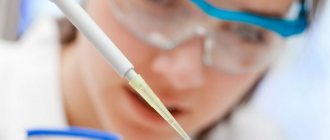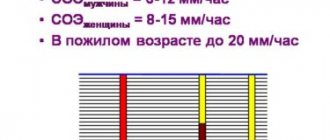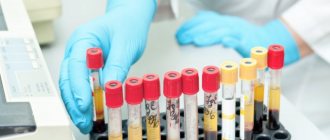Normally, there should not be a single red blood cell in the urine. Sometimes they get there due to heavy load or abuse of spices. But if there are a lot of red blood cells, this often indicates the development of a disease, including cancer. Therefore, it is recommended to consult a doctor as soon as possible and undergo all necessary examinations.
Red blood cells in urine: normal
Normally, there should be no red blood cells in the urine, even in minimal quantities. These are red cells that are found only in blood vessels. They do not pass into the bladder or ureter, and therefore should not be contained in the urine. But in isolated cases, deviation from the norm is acceptable.
Red blood cells can be found in small quantities in the urine due to the following consequences:
- strong physical activity;
- alcohol abuse;
- long period of work literally on your feet;
- certain pathologies;
- too frequent use of spices in food.
Normally, in the urine of both men and women, only 1, 2 or 3 red blood cells can be observed in the field of view. If in fact there are more of them, in many cases this indicates the development of pathology.
General urine analysis
What is a general urine test?
A general urinalysis includes assessment of the physicochemical characteristics of urine and microscopy of sediment. This study allows you to evaluate the function of the kidneys and other internal organs, as well as identify the inflammatory process in the urinary tract. Together with a general clinical blood test, the results of this study can tell quite a lot about the processes occurring in the human body and, most importantly, indicate the direction of further diagnostic search.
Physico-chemical characteristics of urine:
- color;
- transparency;
- specific gravity (relative density);
- pH (acidity);
- protein;
- glucose;
- bilirubin;
- urobilinogen;
- ketone bodies;
- nitrites;
Microscopy of urinary sediment (the study is done in case of pathology in a general urine analysis or at the request of the customer):
Organized urine sediment:
- red blood cells;
- leukocytes;
- epithelial cells;
- cylinders;
- bacteria;
- yeast fungi;
- slime.
- Unorganized urine sediment (crystals).
Indications for the purpose of analysis:
- diseases of the urinary system;
- suspected diabetes mellitus;
- assessment of the toxic state of the body;
- assessment of the course of the disease;
- monitoring the development of complications and the effectiveness of treatment;
- Persons who have had a streptococcal infection (tonsillitis, scarlet fever) are recommended to take a urine test 1-2 weeks after recovery.
Preparing for the study:
On the eve of the study, it is not recommended to eat vegetables and fruits that can change the color of urine (beets, carrots, etc.), as well as diuretics. Before collecting urine, perform a thorough hygienic toilet of the genitourinary organs. Women are not recommended to take the test during menstruation. The container for collecting urine must be clean and dry. To properly collect urine, you need to: during the first morning urination, release a small amount of urine into the toilet, and then, without interrupting urination, place a container for collecting urine, into which to collect about 100-150 ml of urine.
Execution time: 1 working day.
Physico-chemical characteristics.
Color. Normal urine has a straw-yellow color of varying intensities. The color of urine in healthy people is determined by the presence of substances formed from blood pigments (urobilin, urochromes, hematoporphyrin, etc.). The color of urine changes depending on its relative density, daily volume and the presence of various coloring components entering the human body with food, medications, and vitamins.
For example:
- the red color may be due to amidopyrine;
- pink - acetylsalicylic acid, carrots, beets;
- greenish blue - methylene blue;
- brown - bear ears, sulfonamides, activated carbon;
- greenish-yellow - rhubarb, Alexandria leaf;
- deep yellow - riboflavin, 5-NOK, furagin.
Normally, the more intense the yellow color of the urine, the higher its relative density and vice versa. Concentrated urine has a brighter color. However, the normal color of urine does not indicate that it is the urine of a healthy person.
Transparency. Normal freshly passed urine is clear. A small cloud of turbidity may also appear in normal urine due to epithelial cells and mucus. Severe cloudiness of urine can be caused by the presence in it of red blood cells, leukocytes, fat, epithelium, bacteria, and significant amounts of various salts (urates, phosphates, oxalates). The causes of cloudy urine are determined by microscopy of sediment and chemical analysis. Using a three-glass sample, you can roughly answer the question - from which part of the urinary system are leukocytes and mucus released (from the urethra, bladder or renal pelvis). Slightly cloudy urine is often observed in older people (mainly from the urethra). The clouding of urine that occurs when standing in the cold usually depends on the deposition of urates, and in the heat - phosphates. However, clear urine does not yet indicate the absence of diseases of the genitourinary system.
Specific gravity (relative density). Measuring urine specific gravity is a simple test that measures the ability of the kidneys to concentrate urine and dilute urine. A decrease in the concentrating ability of the kidneys occurs simultaneously with a decrease in other renal functions. Normally functioning kidneys are characterized by wide fluctuations in the specific gravity of urine during the day, which is associated with periodic intake of food, water and fluid loss from the body (sweating, breathing). The kidneys under different conditions can excrete urine with a relative density of 1.001 to 1.040.
pH (acidity). The kidneys excrete “unnecessary” substances from the body and retain necessary substances to ensure the exchange of water, electrolytes, glucose, amino acids and maintain acid-base balance. The reaction of urine - pH - largely determines the effectiveness and characteristics of these mechanisms. Normally, most often the urine reaction is slightly acidic (pH 5.0 - 7.0). It depends on many factors: age, diet, body temperature, physical activity, kidney condition, etc. The lowest pH values are in the morning on an empty stomach and the highest after meals. When consuming predominantly meat foods, the reaction is more acidic; when consuming plant foods, the reaction is alkaline. When urine stands, the pH value tends to increase due to the formation of ammonium by microorganisms (pH 9 indicates improper preservation of the sample). Constant pH values (7-8) suggest the presence of a urinary tract infection. Changes in urine pH depend on blood pH: with acidosis, urine has an acidic reaction; for alkalosis - alkaline. A discrepancy between these indicators occurs with chronic damage to the kidney tubules: hyperchloric acidosis is observed in the blood, and the urine reaction is alkaline.
Protein. Protein is normally absent in urine or there are small traces of it, since protein molecules are large molecules that are not able to pass through the membrane of the glomeruli.
Glucose. Normally, there is no sugar in the urine, since all glucose, after being filtered through the glomerular membrane of the kidneys, is completely absorbed back into the proximal tubules. The appearance of glucose in the blood, glucosuria, can be:
- physiological (under stress, taking increased amounts of carbohydrates in older people);
- extrarenal (diabetes mellitus, pancreatitis, diffuse liver damage, pancreatic cancer, hyperthyroidism, Cushing's disease, pheochromocytoma, hyperthyroidism, acromegaly, traumatic brain injury, stroke, poisoning with carbon monoxide, morphine, chloroform);
- renal (renal diabetes, chronic nephritis, acute renal failure, pregnancy, phosphorus poisoning, certain medications).
Glucose is a substance with a high renal excretion threshold. The renal excretion threshold is the concentration of a substance in the blood, exceeding which leads to the cessation of its reabsorption in the tubules. When the blood glucose concentration is more than 8.8-9.9 mmol/l, sugar appears in the urine.
Bilirubin. Normally, bilirubin is practically absent in urine. Formed during the destruction of hemoglobin in the cells of the reticuloendothelial system, about 250-350 mg/day. When the concentration of conjugated bilirubin in the blood increases, it begins to be excreted by the kidneys and is found in the urine. Bilirubinuria is detected in parenchymal liver lesions (viral hepatitis), mechanical (subhepatic) jaundice, cirrhosis, cholestasis. In hemolytic jaundice, the urine usually does not contain bilirubin. It should be noted that only direct (bound) bilirubin is excreted in the urine.
Urobilinogen. Urobilinogen bodies (I-urobilinogen, d-urobilinogen, third urobilinogen, stercobilinogen) are derivatives of bilirubin and are normal products of catabolism, which under physiological conditions are formed at a certain rate, constantly excreted in feces and in small quantities in urine. Normal urine contains traces of urobilinogen. Its level increases sharply with hemolytic jaundice (intravascular destruction of red blood cells), as well as with toxic and inflammatory lesions of the liver, intestinal diseases (enteritis, constipation). With subhepatic (obstructive) jaundice, when there is complete blockage of the bile duct, there is no urobilinogen in the urine.
Ketone bodies. Ketone bodies include acetone, acetoacetic and beta-hydroxybutyric acids. A healthy person excretes 20-30 mg of ketones per day in urine. An increase in the excretion of ketones in the urine, ketonuria appears when there is a violation of carbohydrate, fat or protein metabolism.
Nitrites. There are no nitrites in normal urine. In urine, they are formed from nitrates of food origin (when eating plant foods) under the influence of bacteria, if the urine was in the bladder for at least 4 hours. Detection of nitrites in the urine (positive test result) indicates infection of the urinary tract. However, a negative result does not always exclude bacteriuria. Urinary tract infection varies among different populations and is dependent on age and gender. The following categories of people are more susceptible to an increased risk of asymptomatic urinary tract infections and chronic pyelonephritis, other things being equal:
- girls and women;
- elderly people (over 70 years old);
- men with prostate adenoma;
- diabetic patients;
- patients with gout;
- patients after urological operations or instrumental procedures on the urinary tract.
Microscopy of urinary sediment. In urinary sediment, organized sediment is distinguished (cellular elements, cylinders, mucus, bacteria, yeast fungi) and unorganized (crystalline elements).
Red blood cells. 2 million red blood cells are excreted in the urine per day, which, when examining urine sediment, is normally less than 3 red blood cells per field of view for women, and 1 red blood cell per field of view for men. Anything higher is hematuria. Highlight:
- gross hematuria (when the color of urine is changed);
- microhematuria (when the color of urine is not changed, and red blood cells are detected only under a microscope).
In urinary sediment, red blood cells can be unchanged (containing hemoglobin) and changed (deprived of hemoglobin, leached). The appearance of leached red blood cells in the urine is of great diagnostic importance, because they most often have a renal origin and are found in glomerulonephritis, tuberculosis and other kidney diseases. Fresh, unchanged red blood cells are more likely to cause damage to the urinary tract (urolithiasis, cystitis, urethritis). To determine the source of hematuria, a “three-vessel” test is used: the patient collects urine sequentially into three vessels. When bleeding from the urethra, hematuria is greatest in the first portion (unchanged red blood cells), from the bladder - in the last portion (unchanged red blood cells), with other sources of bleeding, red blood cells are distributed evenly over all three portions.
Leukocytes. Leukocytes in the urine of a healthy person are contained in small quantities (in men 0–3, in women and children 0–6 leukocytes per field of view). An increase in the number of leukocytes in the urine (leukocyturia) indicates inflammatory processes in the kidneys (pyelonephritis) or urinary tract (cystitis, urethritis). To establish the source of leukocyturia, a three-glass test is used: the predominance of leukocytes in the first portion indicates urethritis or prostatitis, in the third - cystitis, an even distribution of leukocytes in all portions can most likely indicate kidney damage. So-called sterile leukocyturia is possible. This is the presence of leukocyturia in the absence of bacteriuria and dysuria (with exacerbation of chronic glomerulonephritis, contamination during urine collection, condition after treatment with antibiotics, bladder tumors, renal tuberculosis, interstitial analgesic nephritis). Urethral syndrome. This is frequent, painful urination and leukocyturia in the absence of bacteriuria. Occurs predominantly in women. In 30-40% of cases in women with symptoms of urinary tract infection, bacteriuria cannot be detected. The reasons for the negative result are that the true causative agent of this condition, as a rule, is anaerobic bacteria, ureaplasma, chlamydia, gonococcus, and viruses. And they all require sowing on special media.
Epithelial cells. Epithelial cells are almost always found in urinary sediment. Normally there are no more than 10 of them in the field of view. Epithelial cells have different origins:
- cells of stratified squamous keratinizing epithelium (washed off with night urine from the external genitalia);
- cells of stratified squamous non-keratinizing epithelium (from the distal parts of the male and female urethra and vagina, of little diagnostic value);
- transitional epithelial cells (lining the mucous membrane of the bladder, ureters, pelvis, large ducts of the prostate gland);
- cells of the renal (tubular) epithelium (lining the renal tubules).
Cylinders. The cylinder is a protein that is coagulated in the lumen of the renal tubules and includes in its matrix any contents of the lumen of the tubules. The cylinders take the shape of the tubules themselves (cylindrical cast). In the urine of a healthy person, single cylinders can be detected in the field of view of a microscope per day. Normally, there are no casts in a general urine analysis. The appearance of casts (cylindruria) is a symptom of kidney damage. The type of cylinders has no special diagnostic significance. Cylinders are distinguished:
- hyaline (with overlay of erythrocytes, leukocytes, renal epithelial cells, amorphous granular masses);
- granular;
- waxy;
- pigmented;
- epithelial;
- erythrocyte;
- leukocyte;
- fatty.
Bacteria. Normally, urine in the bladder is sterile. When urinating, microbes from the lower part of the urethra enter it, but their number is not > 10,000 in 1 ml. Bacteriuria is defined as the detection of more than one bacterium in the field of view (qualitative method), which implies the growth of colonies in culture exceeding 100,000 bacteria per 1 ml (quantitative method).
It is clear that urine culture is the gold standard for diagnosing urinary tract infections. The presence of bacteria in the urine in the absence of complaints is regarded as asymptomatic bacteriuria. A similar condition often occurs with organic changes in the urinary tract; in women who are promiscuous and in older people. Asymptomatic bacteriuria increases the risk of urinary tract infection, especially during pregnancy (infection develops in 40% of cases). The detection of bacteria in a urine test indicates an infectious lesion of the urinary system (pyelonephritis, urethritis, cystitis, etc.). The type of bacteria can only be determined through bacteriological examination.
Yeast fungi. The detection of yeast of the genus Candida indicates candidiasis, which most often occurs as a result of irrational antibiotic therapy, the use of immunosuppressants, and cytostatics. Determining the type of fungus is possible only through bacteriological examination.
Slime. Mucus is secreted by the epithelium of the mucous membranes. Normally absent or present in urine in small quantities. During inflammatory processes in the lower parts of the urinary tract, the mucus content in the urine increases. An increased amount of mucus in the urine may indicate a violation of the rules of proper preparation for taking a urine sample.
Crystals (disorganized sediment). Urine is a solution of various salts, which can precipitate (form crystals) when the urine stands. Low temperature promotes the formation of crystals. The presence of certain salt crystals in the urinary sediment indicates a change in the reaction towards the acidic or alkaline side. Excessive salt content in urine contributes to the formation of stones and the development of urolithiasis. At the same time, the diagnostic value of the presence of salt crystals in urine is usually small.
How is an increased content of red blood cells in urine determined?
The analysis consists of 2 stages:
- Studying the color - if the urine has a brown, reddish tint, this indicates a repeated violation of the norm.
- Microscopic examination - if there are more than 3 red blood cells in the urine, doctors diagnose microhematuria.
When establishing an accurate diagnosis, doctors determine the type of red blood cells:
- Unchanged - they contain hemoglobin, and are found in the urine in exactly the same form as in the bloodstream.
- Modified - alkaline. They do not contain hemoglobin, and the cells lose their red color and become colorless. They look like rings (normally they should look like disks with a biconcave surface).
If blood elements are found in the urine, this clearly indicates a pathological process, and it can be very dangerous. Therefore, you must immediately consult a doctor for further examination and consultation.
How to prepare for the analysis?
For the study to be informative, the material must be collected correctly. General recommendations are as follows:
- you need to buy sterile plastic containers at the pharmacy;
- There is no need to collect the first few drops of urine;
- Before collection, the genitals should be thoroughly washed;
- For women, it is advisable to insert a tampon and spread the labia;
- For women, the test is not recommended during and a few days after menstruation to avoid vaginal discharge;
- morning urine is collected in a container;
- It is enough to collect 100 ml of urine;
- Delivery of the material to the laboratory should take no more than 1 hour.
Usually the result form can be collected the same evening, the material is delivered to the laboratory between 8 and 10:00.
How to collect urine from infants?
With boys, the situation is relatively simple - you just need to wait and place the can in time.
For girls, you can place a circle made from a diaper under the buttocks by placing the dish in the recess. After some time, the child will definitely go to the toilet and the urine will collect in a container.
This way, the child’s parents can easily collect urine for analysis. And its results will not be distorted, which inevitably happens when using other methods, for example, when turning diapers.
Why are red blood cells in urine elevated?
The reasons for the appearance of blood cells in the urine can be very different. For convenience, they are divided into 3 groups:
- Somatic (prerenal) - they are associated not with the excretory system, but with other organ systems.
- Renal – occur against the background of kidney pathologies.
- Postrenal – associated specifically with the excretory system.
If we talk in more detail about the somatic group, we can highlight the following reasons:
- Thrombocytopenia is a decrease in the concentration of platelets in the bloodstream. This leads to blood clotting disorders, which causes red blood cells to end up in the urine.
- Hemophilia is a deterioration in blood clotting, due to which it thins out and also penetrates into the urine.
- Poisoning of the body, for example, due to a bacterial or viral infection.
The main reasons of a renal nature:
- Glomerulonephritis of acute or chronic nature.
- Kidney cancer - the tumor increases in size and destroys the wall of the vessel.
- Urolithiasis – due to stones, the mucous membrane is destroyed.
- Pyelonephritis - inflammation leads to impaired permeability of the blood vessels of the kidneys.
- Hydronephrosis - poor urine flow leads to damage to the walls of blood vessels.
Postrenal causes:
- Cystitis is an inflammatory process in the bladder that causes blood cells to leak into the urine.
- A stone in the ureter, bladder and, as a result, damage to the mucous membrane.
- Bladder cancer damages the walls of blood vessels.
Separately, gender-related reasons can be identified. Thus, in men, pathology is often observed against the background of:
- Prostatitis is an inflammatory process that affects the tissue of the prostate gland. It leads to the entry of red cells into the urine in large quantities, which clearly indicates pathology.
- Prostate cancer – a tumor appears that increases in size and begins to put pressure on the walls of blood vessels. They receive damage through which cells leak.
In women, the cause may be:
- Uterine bleeding - sometimes as a result of injuries, blood from the vagina enters the urine directly when visiting the toilet.
- Cervical erosion - a wound appears on the uterine mucosa, often due to traumatic exposure, sexually transmitted infections or hormonal imbalance. As a result, secretions are released, including those mixed with blood, which ends up in the urine.
How to detect hematuria?
Visible hematuria often bothers patients and forces them to see a doctor.
Microhematuria is determined by microscopy of urine sediment.
What tests are needed to make a diagnosis?
Any patient with gross hematuria or significant microhematuria should undergo a comprehensive evaluation of the urinary tract. The first step is a thorough history and physical examination. Next, a laboratory urine test and examination of the urinary sediment under a microscope are performed. The urine is tested for protein (a sign of kidney disease) and urinary tract infections. The number of red blood cells in the urine (erythrocyturia) and the content of leukocytes in the urine (leukocyturia) are determined. A urine cytology test is needed to check for abnormal cells. Laboratory blood tests are performed to measure serum creatinine levels (kidney function tests).
Patients with significant protein in the urine or elevated creatinine levels should undergo additional testing to rule out kidney disease.
A complete urologic examination in patients with hematuria also includes x-rays of the kidneys, ureters, and bladder (an overview of the urinary system) to rule out masses and stones. Excretory urography is performed - a method for determining kidney function, based on the introduction of radiopaque agents into the bloodstream, followed by radiography and determination of the release of dye by the kidneys.
Many doctors may choose other imaging tests, such as computed tomography (CT) or multislice computed tomography (MSCT). These methods are preferred and more informative for assessing the condition of the kidneys, and are also the best methods for assessing urinary stones. Recently, many urologists have been using CT urography. This allows the urologist to look at the kidneys and evaluate the condition of the ureters as a result of a single x-ray. In patients with elevated creatinine levels or allergies to radiocontrast agents, magnetic resonance imaging (MRI) or retrograde pyelography is performed to evaluate the upper urinary tract. During retrograde pyelography, the patient is taken to the operating room, a radiopaque contrast agent is injected into the kidney through a ureteral catheter, followed by radiography.
Patients with hematuria undergo cystoscopy under local anesthesia using a rigid, or more often, flexible instrument - a cystoscope. After anesthesia, a cystoscope is inserted through the urethra into the bladder and the bladder and urethra are assessed for the presence of masses.
What to do if there was or is hematuria, but no cause was found as a result of the examination?
In at least 8-10 percent of cases, no cause for hematuria is found. Some studies have shown an even higher percentage of patients without a cause. Unfortunately, we have to admit that the same studies later showed that 3 percent of patients were later diagnosed with malignant tumors of the urinary system.
Thus, there is a risk of underexamining the patient or failing to determine the initial stages of some formations. There are no recommendations for subsequent comprehensive examination. Also, there is still no consensus among urologists on this topic.
It is still recommended to consider repeating urine and cytology tests at 6, 12, 24 and 36 months. In the case of repeated gross hematuria, a positive result of urine cytology, or the appearance of irritating urinary symptoms such as pain during urination or frequent urination, an immediate reassessment of the condition of the urinary system is carried out with cystoscopy and repeated radiological diagnostic methods. If none of these symptoms are detected within three years, no further urological examination is required.
Cases of complications
Sometimes not only red blood cells are found in the urine, but also other blood cells - leukocytes, as well as protein compounds. This is clearly a pathological condition, which indicates the development of pathogenic processes. As a rule, they are associated with the following reasons:
- hemorrhagic cystitis;
- urolithiasis;
- inflammation in the kidneys;
- tuberculosis;
- tumors of various nature in the urinary tract.
It is important to take action immediately and get tested. Otherwise, kidney pathology can become chronic, resulting in renal failure.








